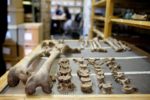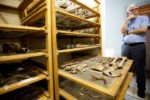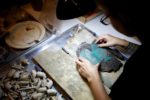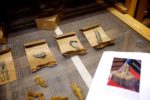 Archaeologists in Montreal are trying to identify the remains of, among other individuals, a soldier whose bones were unearthed last year during construction work. A Hydro-Québec discovered the bones when laying a power line underneath one of Montreal’s central thoroughfares, René Lévesque Boulevard. Then they found more. These were the remains of people interred in a Protestant cemetery that was in use from the late 18th century through the middle of the 19th.
Archaeologists in Montreal are trying to identify the remains of, among other individuals, a soldier whose bones were unearthed last year during construction work. A Hydro-Québec discovered the bones when laying a power line underneath one of Montreal’s central thoroughfares, René Lévesque Boulevard. Then they found more. These were the remains of people interred in a Protestant cemetery that was in use from the late 18th century through the middle of the 19th.
Known variously as the Dufferin Square Cemetery, the Saint Lawrence Burial Ground and the Dorchester Street Cemetery, the Protestant cemetery was created in 1797 outside the city walls of what is now Old Montreal. It was made necessary by the city’s rapid population growth after the British conquest of French Canada, ushered in by the Surrender of Montreal in 1760 and formalized in the 1764 Treaty of Paris. The cemeteries inside the city walls were overcrowded and taking up increasingly valuable real estate, and authorities were concerned about all that decaying flesh spreading infectious diseases like cholera amongst the living. (John Snow’s ground-breaking epidemiological study identifying fecal contamination in drinking water as the source of cholera was still more than 50 years away.)
 Because there were laws against Protestants and Catholics being buried together, the city authorized two new cemeteries in the suburbs. The Protestant one opened first; the Catholic one followed two years later. Montreal’s Protestant residents were given the opportunity to move their loved ones’ remains to the St. Lawrence. Over the next few years as the old city cemeteries were sold off for development, people scrambled to transfer remains before they were built over. One of those people was fur trader and successful entrepreneur James McGill, best known today as the founder of McGill University. His dear friend and former business partner John Porteous had been buried in one of the old city cemeteries and in 1799, Porteous’ remains were in danger of being unceremoniously ploughed under when the land was reclaimed for new construction. McGill personally saw to it that Porteous’ body was moved to the shiny new Protestant cemetery in the burb and buried in the plot he had bought for himself.
Because there were laws against Protestants and Catholics being buried together, the city authorized two new cemeteries in the suburbs. The Protestant one opened first; the Catholic one followed two years later. Montreal’s Protestant residents were given the opportunity to move their loved ones’ remains to the St. Lawrence. Over the next few years as the old city cemeteries were sold off for development, people scrambled to transfer remains before they were built over. One of those people was fur trader and successful entrepreneur James McGill, best known today as the founder of McGill University. His dear friend and former business partner John Porteous had been buried in one of the old city cemeteries and in 1799, Porteous’ remains were in danger of being unceremoniously ploughed under when the land was reclaimed for new construction. McGill personally saw to it that Porteous’ body was moved to the shiny new Protestant cemetery in the burb and buried in the plot he had bought for himself.
Montreal’s continued expansion in the 19th century ensured the new Protestant burial ground was soon as overcrowded and inconvenient as the ones inside the old city had been. The roomier Mount Royal Cemetery opened in 1852. Two years later, the old cemetery was closed to new burials and left to its own devices. Reclaimed by nature, its headstones broken and leaning precariously, graves sunken, the grounds studiously unmaintained with weeds as high as an elephant eye, the cemetery was razed in 1875 to make way for Dufferin Square, a public green space off Dorchester Boulevard. (The elegant street, dotted with mansions and running through Old Montreal, would be expanded into an eight-lane artery running east-west through Montreal in 1955 and renamed René Lévesque Boulevard in 1987.)
 Again the city alerted people that it was going to go down so if they wanted their deceased to rest in peace, they’d have to move the remains themselves. Some of Montreal’s most famous sons were buried in the St. Lawrence Burial Ground. James McGill was interred there in 1813 alongside his old friend John Porteous. (He couldn’t be buried next to his wife because she was Catholic.) John Molson, founder of the brewery that still bears his name, was buried there in 1836. They and other wealthy, prominent people were moved. McGill was reinterred on the campus of the university that bears his name. Molson and other big shots were moved to Mount Royal. The poor, tradespeople, middle class, people without surviving family or who had simply been forgotten, were left behind.
Again the city alerted people that it was going to go down so if they wanted their deceased to rest in peace, they’d have to move the remains themselves. Some of Montreal’s most famous sons were buried in the St. Lawrence Burial Ground. James McGill was interred there in 1813 alongside his old friend John Porteous. (He couldn’t be buried next to his wife because she was Catholic.) John Molson, founder of the brewery that still bears his name, was buried there in 1836. They and other wealthy, prominent people were moved. McGill was reinterred on the campus of the university that bears his name. Molson and other big shots were moved to Mount Royal. The poor, tradespeople, middle class, people without surviving family or who had simply been forgotten, were left behind.
Over time, the exact location of the cemetery was forgotten until in the late 1970s a massive government office building was built on Dufferin Square. Planners thought they’d taken care of the whole cemetery situation by taking a page out of the Leicester handbook and turning it into a parking lot, but when construction of the Complexe Guy Favreau began, they started turning up body after body, eventually unearthing more than 100 sets of human remains. Some were reburied in Mount Royal, but rumor has it there are a lot of restless spirits lingering at the site and the complex has a reputation for being haunted by some very angry ghosts.
Even with this ghoulish history looming in the background, archaeologists didn’t expect to find the bones of dozens more people when the work on the power line was done last year.
“We weren’t certain if we were within the cemetery borders or not,” says André Burroughs, an archeologist with Hydro-Québec who oversaw the work. “At first, we were surprised.”
The discovery turned up the remains of 61 individuals, many of them just bones gathered in collective burial boxes. […]
About half the individuals’ remains were discovered inside three pine boxes. They were probably exhumed from the original Protestant cemetery in Old Montreal and re-buried collectively.
The officer’s skeleton and military accoutrements offer some of the most extensive clues into someone’s personal history. The man had suffered from poor nutrition, based on marks found on his teeth.
He was fairly tall – about 5-foot-10 – and lived to middle age, judging from his long bones. His body shows no trauma to indicate he was injured in battle.
 Some of the bones discovered during the construction of the Complexe Guy Favreau also belonged to soldiers, identified as members of the British garrison who guarded Montreal before 1814. Perhaps he was one of their comrades.
Some of the bones discovered during the construction of the Complexe Guy Favreau also belonged to soldiers, identified as members of the British garrison who guarded Montreal before 1814. Perhaps he was one of their comrades.
The bones are being kept in a laboratory for study at the moment. Once the research is done, the plan is to give them to the city of Montreal to store in its extensive archaeological collection, but this story has gotten a lot of media attention and a number of individuals and organizations have offered to provide a more personal disposition for the remains.
The Last Post Fund, whose National Field of Honour is in suburban Pointe-Claire, says it would consider burials for any soldiers. The St. Andrew’s Society of Montreal expressed interest in caring for the remains of Scottish Montrealers. Two women wondered whether the remains might be those of their ancestors, and one offered a DNA sample.
Mr. Burroughs says the remains could eventually end up at the Mount Royal Cemetery on the mountain, following the path that their predecessors took about 160 years earlier.
Gosh! – Judging by the impressive amount of pipes it was allegedly buried with -to cough up a hypothesis- that poor child was a rather heavy smoker: Canada is different, it seems – Even passive smoking kills!
I note you wrote: “Because there were laws against Protestants and Catholics being buried together, the city authorised two new cemeteries in the suburbs”. But who gave that ruling – the churches or the local government? Who would break up husbands and wives in death?
I just found this while doing family history research. Is there any further research on going into the DNA of the remains? If so who would you contact. My wife’s 4th GGFather Alexander Henry the Elder may be one of those buried there. K